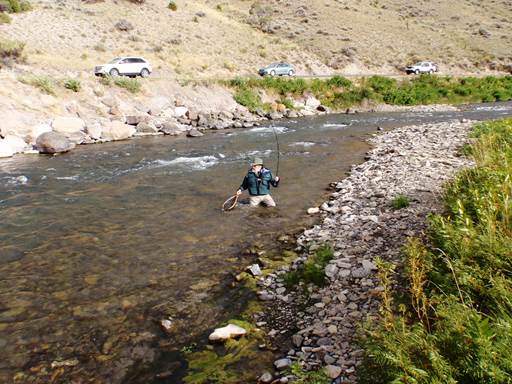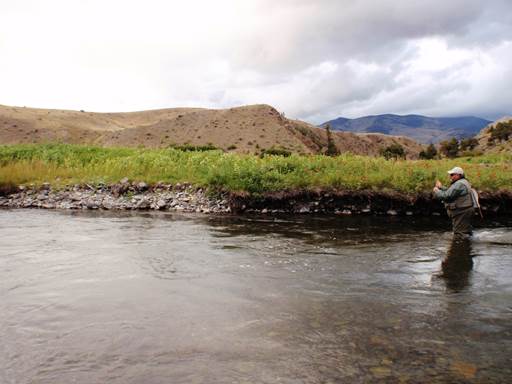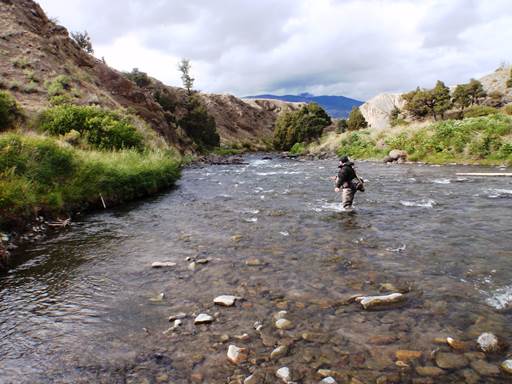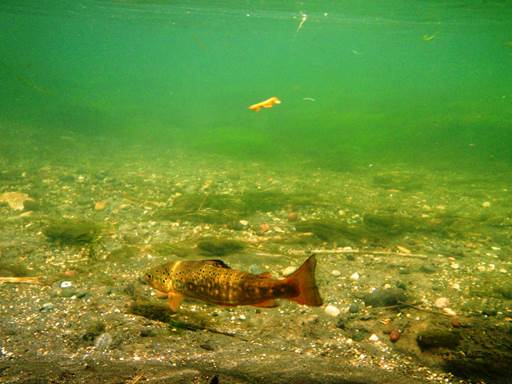THE FLY FISHING CHRONICLES OF YELLOWSTONE NATIONAL PARK – PART 4
| Sysadmin Note |
|---|
| Part 3 can be found here |
As you enter the north entrance of Yellowstone National Park which is located on the outskirts of Gardiner Montana you don't drive very far and the first river that you encounter is the Gardner. To many of the visitors the Gardner appears to be that typical brawling western freestone stream as it rush and tumbles on its way to join the Yellowstone River. The Gardner runs close to the road for several miles however many anglers take one look at the rocky bottom and the turbulent water and keep heading further into the park to some of the more famous streams that are easier to wade.
The famed Lewis and Clark expedition 1804 to 1806 never explored the Yellowstone Park area they traveled north of the Park neither did John Colter who was with the expedition and returned to the area in 1809, though there may have been others the town of Gardiner Montana and the Gardner River was name for Johnson Gardner who was a free trapper who worked the area between 1830 and 1831. Later during the 1870 Washburn, Langford and Doane Expedition which was the first expedition to map and explore the park area. During the expedition a phonetic mistake occurred and that is why the river is call Gardner and the town is called Gardiner both with different spelling.
The park was formally established March 1st 1872 by President Ulysses S. Grant and the town of Gardiner officially began on February 8th 1880 with the establishment of the territorial post office and thus concludes the little history lesson and now we will return to the important information on the river.
The Gardner River begins high on the slopes of Joseph Peak in the northwestern section of the Park and is around twenty five miles in length as the Gardner tumbles down is join by Straight Creek, Fawn Creek, Winter Creek, Panther Creek, Indian Creek and Obsidian Creek.

Then we come to Sheepeaters Cliff and Osprey Falls which is one hundred feet in height and after tumbling down over Osprey Falls the river turns north and is joined by Glen Greek and Lava Creek. It continues to flow north and for a while it is just off the main entrance road, it enters the Yellowstone River just to the south of the town of Gardiner Montana, the entire length of the river is contained within the boundaries of Yellowstone National Park.
From a trout fishing standpoint the Gardner River is broken down into two sections, above Osprey Falls the river and the tributary streams contain Brook Trout and to the causal angler they all appear to be six to ten inches in length however there are larger Brook Trout in these waters for those who are patient and willing to explore.
The section of river below Osprey Falls contains Rainbows, Browns, Cutthroats and Whitefish and the park rates the size range between eight to fourteen inches. During September and October Brown Trout from the Yellowstone River run up the Gardner to spawn and during this time period Brown Trout from Twenty to Twenty Four inches have been taken.
During the early summer of late June to early July the Salmon Flies Pteronarcys californica hatch along the river and during this time period it seem that larger trout seem to appear in the river to feed on this large food source during the hatch you can also take trout up to twenty two inches or so, it is claimed that these trout move up from the Yellowstone River to feed.

However I believe that some trout may move up from the river that many more of the larger trout live in the Gardner River on a year round basis. I actually target the Gardner Rivers a few days each season for my own personal fishing. Seldom do clients ask to go there and then the Gardner is always the last resort, which is sad as the Gardner has riffles, pools and runs just like the grownup rivers and offers all the challenges of any other stream.
For most anglers who have done a little research the Gardner River is not high on the list of rivers to fish streams like Slough Creek, Lamar River and Soda Butte Creek are much more enticing as these streams hold larger trout on average.
However, there are times when the weather can drive you from some of the other streams and as you head to the entrance you find that the weather on the Gardner is far different that the weather you encountered on the streams in the northeast corner of the park and you did come to fish so you give the Gardner River a try. Some are successful, many are not because they are not familiar with the stream and they have heard that the Gardner River has smaller trout therefore they figure that the smaller trout are easy to fool and fail to show the proper respect for this fishery and thus are often frustrated and fishless.
I know this is true as I have watched this happen many times over the years, the size of the trout has nothing to do with the ease of catching the trout. One afternoon is late September we had be blown off of the Lamar we stopped and checked out Slough Creek but it blowing there as well, when I say we were blown off the wind were thirty miles per hour and I know that superman can cast in winds like that but none of my clients nor myself is gifted enough to fish under those conditions.
By the time we reached the Gardner River we found ourselves in a different weather system and decided to stop and fish, we had been blown off before the Baetis hatch and I knew of a decent pool where I the Baetis fishing was normally pretty good, we park and geared up and head to the pool and found that no one else was there fishing and we barley arrived before the trout began to feed. I checked the water and sure enough the Baetis were beginning to emerge, I told them that the same patterns that we had planned to use on the Lamar would work here on the Gardner and we had discussed the patterns and techniques as we had driven back towards the Gardner.

One angler moved to the head of the pool were the riffle entered and began to fish, soon he was into a nice rainbow trout using a size 18 Hot Top Baetis Paradun with size 18 Olive Sawyer PT Nymph dropped sixteen inches behind the dun.
The other angler had move down to the bottom of the pool and began to fish the tailout I continue to watch the angler at the head of the pool and soon he had another Rainbow and both were taken on the nymph which was normal for that time period of the hatch.
I kept looking back down to the other angler and I still hadn't seen him hook a trout so I head downstream to see what the problem was. The first thing that I notice was the dry fly was larger and different from what I suggested, he tangled the cast and reached to untangle it and noticed the nymph was larger and on a longer dropper than I had recommended, when I asked about the different flies, he replied that "I saving my Baetis patterns for real trout and how tough could these small trout be!"
Well, I just looked at him and said I guess you will find out and twenty minutes later he still had not hook a trout and there were several actively feeding within easy casting range.

Finally I suggested that we use the patterns that I had suggested earlier and soon he had a nice eleven inch brown trout in the net. I carefully use a stomach pump and show him that the trout use full of the small Baetis Nymphs and Dun and that is why the flies worked. I also explained that size of the trout has nothing to do with selective feeding especially during a hatch, as they are feeding on what they are seeing and the size of the trout has very little to do with how easy they are to catch.
Now in faster heavier water you might be able to get away with a larger pattern, but would find that matching the hatch will still get you more trout. This is an important lesson to remember.
The Gardner River is a fun fishery that offers fine fishing and many challenges that the angler must adapt to and overcome. So the next you need a place to fish after the weather has pushed you off your regular water or maybe you only have a short day to fish then give the lower Gardner River a try.
Enjoy & Good Fishin'
| Sysadmin Note |
|---|
| Part 5 can be found here |
